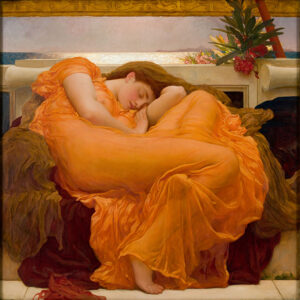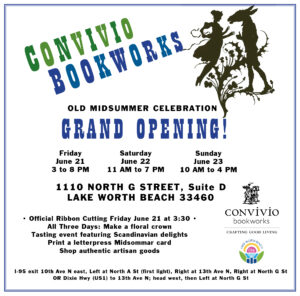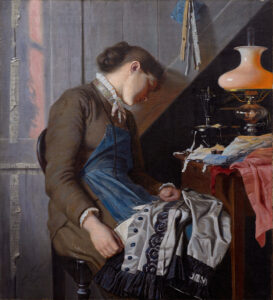It was in 1935 that Billie Holiday recorded a song with Teddy Wilson and his Orchestra; a song called “It’s too Hot for Words,” and though it is not the official State Song of my home state of Florida, I think perhaps it should be. And I think the sleeping woman in this iconic painting of summer understands this, too. The painting, called “Flaming June,” is by Frederic Lord Leighton. The sun shimmering on the distant water, and its stillness, and the flush on the cheek of the sleeping woman in orange… all these things suggest that it was the very height of summer, perhaps Midsummer Day itself, when Frederic Lord Leighton painted this image in 1895. Whatever summer day it was obviously was too hot for words and, by the looks of things, too hot for pretty much anything.
And “Flaming June” is the cover star this month for your Convivio Book of Days calendar. The calendar for June is, as usual, a printable PDF. It is the month of St. Anthony of Padua’s Day on the 13th: a favorite saint of both my grandmothers and perhaps all Italian grandmothers, for that matter. And then comes Bloomsday, one of our favorite literary holidays, then Father’s Day and Juneteenth, the freedom celebration that is our newest national holiday. The solstice arrives this year on the 20th, and a few days later come the celebrations of Old Midsummer. Mostly ignored in this country, Midsummer will pass largely unnoticed. But these longest days of the year in the Northern Hemisphere are magical days, with daylight well into the evening hours. In Sweden and Germany and other places folks stay out well into those nights and there are songs to sing and dances to dance beneath a Midsommar pole and they will don flowers in their hair and laugh and love while here in the States we will just go to bed early and wake up early and go to work diligently and that is that.
Ah, but these lovely lengthy languid days are the polar opposite spoke in the Wheel of the Year to the celebrations of Midwinter, which we do celebrate most joyously. That is Christmas, when the days are short and the nights are long, and these summery days are the mirror to Christmas. Ages ago, the Church placed the birth of Christ at the Midwinter solstice and the birth of his cousin, St. John the Baptist, at the Midsummer solstice. This, for powerful symbolism: John is born at Midsummer, just as light begins to decrease. “He must increase, but I must decrease,” we read in John 3:30. Conversely, Christ is born at Midwinter, just as light begins to increase. Again, in John 8:12: “I am the light of the world.”
There are other traditional bits of magic in the air this time of year, too. While there is one school of thought that says William Shakespeare set his comedy A Midsummer Night’s Dream at the Eve of May, there is another that places it at St. John’s Eve. That’s the school of thought I subscribe to. St. John’s Eve, on the 23rd of June, mirrors Christmas Eve in that Wheel of the Year, and we all know about the particular magic of that long night. So on the short night, too.
Do with all this what you may. Go to work if you must… but honor these magical days as best you can. This is what we do, and this, I think, is a very good approach.
COME SEE OUR NEW SHOP!
We’ll be open this Saturday, June 8, and next Saturday, June 15, for Father’s Day shopping (and any kind of shopping) from 11 AM to 4 PM, and, in fact, these are the hours we’ve decided to keep all year long. Unless otherwise noted, we’ll be open every Saturday from 11 to 4. We both work full time, so Saturday hours are the best we can do for now. We’ll also gladly open for you by appointment, should Saturdays not work for you. Just write us. The new shop is at 1110 North G Street, Suite D, Lake Worth Beach, FL 33460. From I-95, exit 10th Avenue North eastbound; make a left at the first traffic signal onto North A Street, then at the first stop sign, turn right onto 13th Avenue North. Cross the railroad tracks and turn right again onto North G Street. We’re a couple blocks down on your left side in a blue-roofed building. Plenty of street parking on G Street and there are a few spots in our little parking lot, too.
COME TO OUR GRAND OPENING!
It’s a Midsummer celebration! Official ribbon cutting with City officials on Friday June 21 at 3:30 PM, and we’ll be open all that weekend (Friday June 21 from 3 to 8 PM, Saturday June 22 from 11 AM to 7 PM, and Sunday June 23 from 10 AM to 4 PM) with lots of Midsummer fun: We’ll teach you how to make a floral crown; You can print your own letterpress printed Glad Midsommar card; Enjoy a free tasting event featuring many of our Scandinavian specialty foods, and, of course, there will be great shopping and good company. The new shop is at 1110 North G Street, Suite D, Lake Worth Beach, FL 33460. From I-95, exit 10th Avenue North eastbound; make a left at the first traffic signal onto North A Street, then at the first stop sign, turn right onto 13th Avenue North. Cross the railroad tracks and turn right again onto North G Street. We’re a couple blocks down on your left side in a blue-roofed building. Plenty of street parking on G Street and there are a few spots in our little parking lot, too.
SHOP OUR SUMMER DAY SALE!
At our online catalog right now, you may use discount code BLOSSOM to save $10 on your $85 purchase, plus get free domestic shipping, too. That’s a total savings of $19.50. Spend less than $85 and our flat rate shipping fee of $9.50 applies. CLICK HERE to shop; you know we appreciate your support immensely. And yes, you may use that $10 discount when you visit us in the store, too!
Image: “Flaming June” by Frederic Lord Leighton. Oil on canvas, 1895 [Public domain, via Wikimedia Commons]. Click on each image to make them larger!




